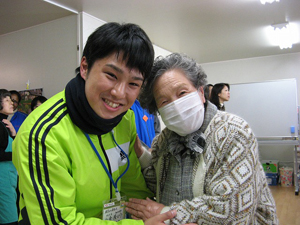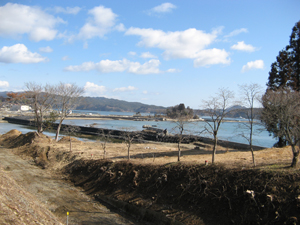Top>Research>Legal issues in disaster reconstruction seen from cases on the Sanriku Coast (Part I)
 Index
Index

Hideo Nakazawa [profile]
Education Course
Legal issues in disaster reconstruction seen from cases on the Sanriku Coast (Part I)
Hideo Nakazawa
Professor of Political Sociology and Community and Regional Sociology, Faculty of Law, Chuo University
1. Foreword
I entered the Sanriku disaster region, witnessing the terrible scene with my own eyes (August 2011), and now a year has past since I began thinking about what I could do. During that time, I have set up the Chuo University Volunteer Network (I have worked in the official position of student volunteer manager since April 2012. Activities can be seen in photograph 1), and I have done my best to establish volunteer activities and be involved in regional revitalization for the affected areas. In terms of details and knowledge, I have offered a little in my books (2011; 2012). In all I have spent more than 30 days in coastal disaster zones, centered on Kesennuma and Ishinomaki, but have failed to put a large part of the information I have acquired into writing. Due to nature and fluidity of the situation, there are many things that cannot be shown in print at the present time, and there are also many areas where results cannot be verified without waiting a set period of time. Also, there are things that could have been stated as fact in the past, but can no longer be stated as so. That is the extent of the speed in which policies and reality have being changing. There are no easy to understand jobs for first-time volunteers remaining (in Miyagi Prefecture at least), which is an important part of this change.

Photograph 1 Volunteer activities
For this reason, what I would like to emphasize first of all is that the passage of time in the current disaster region has been extremely fast. Under normal administration, the enormity of the operations required would take several years to more than ten years to take place, but the paperwork has been completed in units of several months, and each department is now moving into the next phase. Therefore, it may be possible for people who live a bit further away from the disaster area, and those who only visited last summer, to have a misunderstanding of the reality of the situation at this present time (and it is needless to say that the vague images presented through mass-media are far from the realities of any specific place.) In regards to the Great East Japan Earthquake, if you don't continually make clear, "what point of time is being talked about" or "what region is being talked about", there will be total discrepancies in talks between other people when the same disaster area is being talked about.
While having reservations as mentioned above, I thought it necessary to sum up the past year. Especially, in regards to legal and institutional issues that have emerged, because investigations will need to be made over a period of time, I think it is appropriate to take this opportunity to bring up those issues.
2. Inadequate legal systems relating to disasters
The 2011 Great East Japan Earthquake was an unprecedented disaster and wide-spread to the extent exceeding the projections of disaster related legal systems up until then. That is because many of the related laws given below are not mentioned in the general six codes of law, it is a minor field in jurisprudence, and there are many laws that are only known in disaster related societies. In the six months following the disaster, disaster researchers frequently pointed out that, "local administrative officers don't know the Disaster Relief Law", but that was not to be a surprise.
The Disaster Relief Law, which was enacted in 1947, is a typical law that never went under any kind of drastic reform as it received little attention. Anyone who read the text would be surprised at the extremeness of the mishmash (large amounts of the text have been deleted, the ideas are out of touch with the times, and important areas have all been entrusted to ministerial ordinances) and the archaic language used. Especially in regards to temporary housing, which is expected to have become the focus of disaster relief since the Great Hanshin and Awaji Earthquake, only the phrase "emergency temporary housing" has been added to the text as one of the relief measures to be enacted by the prefectural governor. Details have all been set in accordance to Ministry of Health, Labour and Welfare (MHLW) announcements and notifications, and those have all been put together into one thick book. In the past year and a half, there have been an extremely large number of disputes surrounding temporary housing (unit construction standards, precautions against the cold and installation of reheating functions for baths, pros and cons of transfers to empty units, and the two year limit for installation), and all of those become internal regulation issues of MHLW. From a systematic and democratic regulatory viewpoint, there are bound to be major problems. Before a once in a millennium disaster, while not trying to do away with the compilation of announcements and notifications that have been made on the assumption of disasters from the most recent decades, notifications are made to deal with new realities. So, by using narrow logic, difficult to understand regulations are somehow produced. (As an example, there is the empty unit transfer issue. According to an August 12, 2011 MHLW announcement, "regarding the construction of emergency temporary housing in the disaster zone, as it can be expected that empty units will appear in communities in the future due to people moving into permanent housing, while giving priority to those who wish to move into emergency temporary housing, we want to be flexible and respond to the true state of affairs in the community by using the units for community-building gatherings and conversation spaces etc." This can be interpreted as approving the transfer of the units to become meeting places without taking down the fa巽ade of disaster relief. However, there is a wide range into how regional bodies interpret this notification. Kesennuma has approved the transfer only for housing of emergency administrative officials. This is probably the result of combining fairness with disaster relief logic.)
The Act Concerning Support for Reconstructing Livelihood of Disaster Victims (2000), which was revised, based on the Great Hanshin and Awaji Earthquake and Chuetsu Offshore Earthquake, when put in front of the reality of the scale of the Great East Japan Earthquake, problems also arise with this law and independent thinking structure. I will touch upon this more in the next section.
3. Property rights and compensation
Differing from the Great Hanshin and Awaji Earthquake, the government's logic of "government money cannot be invested put into victims' individual capital accumulation" fell on deaf ears. The sort of revolutionary change that is unexpectedly taking place is surprising. Not only that, the investment of national funds to individual victims of this disaster, although via local governments, taking place in a versatile manner is a distinguishing feature. It does not stop with payment under the Act Concerning Support for Reconstructing Livelihood of Disaster Victims (1 million yen each plus an additional 2 million yen in the case of a house rebuild.) The Group Relocation for Disaster Mitigation Scheme application conditions and implementation standards have especially been eased in the management aspect based on feedback from the field. For example, even if one relocates to land owned by that individual, if it involves group relocation with another household, they will be eligible for the scheme. It is estimated that land that was inundated and submerged by seawater (photograph 2) and land designated as a disaster hazard area and uninhabitable, will inevitably be purchased with government funds for 60-70% of the pre-disaster value. In the background of this generosity, are social security payments for individuals, in the form of agricultural / semimountainous region household compensation and child allowances, being taken as a matter of course since the Democratic Party of Japan came to power, influencing change in the handling of the welfare state. However, households and individuals who quickly rebuilt by their own means, in order to adapt to the continual changes in the system, are harboring a sense of injustice. In addition, due to the design of minor zoning designations (for example, whether to designate land as a hazard area for houses near cliff face or not), even if they are adjacent houses, some will be covered by the system, and others will not, causing disputes between neighbours and at government offices.

Photograph 2 Configuration of land submerged by the tsunami has changed (the Kesennuma Line used to run in the bottom left of the picture)
Also, with a focus on Fukushima, under the Atomic Energy Damage Compensation Law (reference: Atomic Energy Compensation and Restoration), the limits of the compensation structure are being quickly exposed. People who return to work early have that amount of their wages deducted from the compensation (however, fixed sum corrective measures have been devised in 2012.) For that reason, the system was criticized for taking away people's independence and desire. When a large number of people are forced to move their original lifestyle foundations to a completely different location, how should the difference between "cases with no illegal conduct" and "cases with illegal conduct" be calculated? This again raises the question of the concept of damages in the property law system of civil law. Shouldn't we be drawing close to individual structures of living and handle consultative functions, like receiving lifestyle rebuilding consultations, as part of compensation? (There are several postwar examples of this type of consulting being provided by extra-governmental organizations such as the Council for Unemployed Miners and the Employment Promotion Corporation.)
This is not limited to Fukushima, if so much government funding is going to be provided it is highly possible that, if an order-made method that matched the situations of each individual or household, savings could have been made with an efficient rebuild. It may surprise those of you who haven't heard this before but, construction and installation fees have been estimated at 5 million yen per house, however, by later adding bath reheating functions, the costs in Miyagi Prefecture, including fees for dismantling, are seen to be more than 8 million yen per house (Jiji Press, May 12, 2012). In theory, including the previously mentioned Act Concerning Support for Reconstructing Livelihood of Disaster Victims, the government will have spent 11 million yen on each household for moving into temporary housing and rebuilding. If the same amount were going to be used, more people would be happier if they evacuated to rented apartments in other regions instead of temporary housing (so-called presumed temporary housing), with that amount appropriated toward rebuilding of houses and businesses (of course, this flexible method cannot be used under the current legal system and is just a simple calculation of costs.) At any rate, it is possible to, if it is going to take 4-5 years of living in temporary housing until group relocation is realized, devise good temporary housing plans such as building wooden houses or care giving-compatible houses, then construction standards to suit individual situations should have also been possible (actually, wooden housing was built in Sumida-cho, Iwate Prefecture, and care giving-compatible housing in Tono City, later to be ratified by the government.)
In any case, in order to coordinate matters to suit the structure of living of each household, and because there isn't enough manpower for this to take place at local government office counters, social workers or personal counters like those at local comprehensive support centers in the social welfare field, are also needed in the reconstruction field. That kind of personal comprehensive regulatory functions or comprehensive compensation support functions were completely overlooked by the disaster related laws. Even if based on the current temporary housing and disaster victim management structures set up by each local government, such as "bond support workers" and "temporary housing liaison committees", which don't necessarily function well, a one-stop, semi-governmental counter to deal with changes in structures of living is needed. Isn't there a lesson to be learned here for the predicted three-plate earthquake?
(Part II will follow. Part II will deal with the three themes of disaster prevention and urban development, intergovernmental relations, and new communities and universities.)
Bibliography
- Hideo Nakazawa 2011, Hisaichi Shien To Saigai Bunka [Disaster Region Support and Disaster Culture], "Chuo Hyouron" Volume 278 : pp.49-60
- Hideo Nakazawa, Hiroto Suzuki, Yasuko Tsuru, Yuri Komuro, Yuji Miyamaru 2012, Chuo Daigaku No Hisaichi Borantia "Fuyu Bora" Hokoku [Chuo University's Disaster Region Volunteers "Winter Volunteer" Report], Chuo Online January 2012
References
- From this year, Chuo University's volunteer activities on the Sanriku coast are continuing in the form of student organizations (http://www.chuo-u.ac.jp/chuo-u/eminfo/index_j.html#eminfo04).Those results will be continually published in Gakuin Jiho, Hakumon Chuo and Kusa no Midori etc. We are also continuing collections of alumni association donations to support the volunteer activities of the students (http://www.chuo-u.ac.jp/chuo-u/news/contents_j.html?suffix=k&visit=11&mode=vst&topics=15902).
- Hideo Nakazawa
Professor of Political Sociology and Community and Regional Sociology, Faculty of Law, Chuo University - Born in Tokyo. Graduated from the University of Tokyo in 1994. Received doctorate (sociology) from the University of Tokyo in 2001. Started his current position in 2009 after working as a lecturer at the Faculty of Social Information, Sapporo Gakuin University, and associate professor at the Faculty of Letters, Chiba University. Is a member of The Japan Sociological Society and the Japan Association of Regional and Community Studies. Major publications include, Juumin Tohyou Undou To Rookaru Rejiimu [Local Referendum Movements and the Local Regime] (Harvest-sha), dealing with nuclear issues in Niigata Prefecture, and Kankyou No Shakaigaku [Environmental Sociology] (coauthored, Yuhikaku), on a wide range of themes including waste, nuclear energy and environmental culture. The former title was awarded the 5th Japan Sociological Society Encouragement Award and the 32nd Tokyo Institute for Municipal Research Fujita Award.
- Research Activities as a Member of Research Fellowship for Young Scientists (DC1), Japan Society for the Promotion of Science (JSPS) Shuma Tsurumi
- Important Factors for Innovation in Payment Services Nobuhiko Sugiura
- Beyond the Concepts of Fellow Citizens and Foreigners— To Achieve SDGs Goal 10 “Reduce Inequality Within and Among Countries” Rika Lee
- Diary of Struggles in Cambodia Fumie Fukuoka
- How Can We Measure Learning Ability?
—Analysis of a Competency Self-Assessment Questionnaire— Yu Saito / Yoko Neha - The Making of the Movie Kirakira Megane








